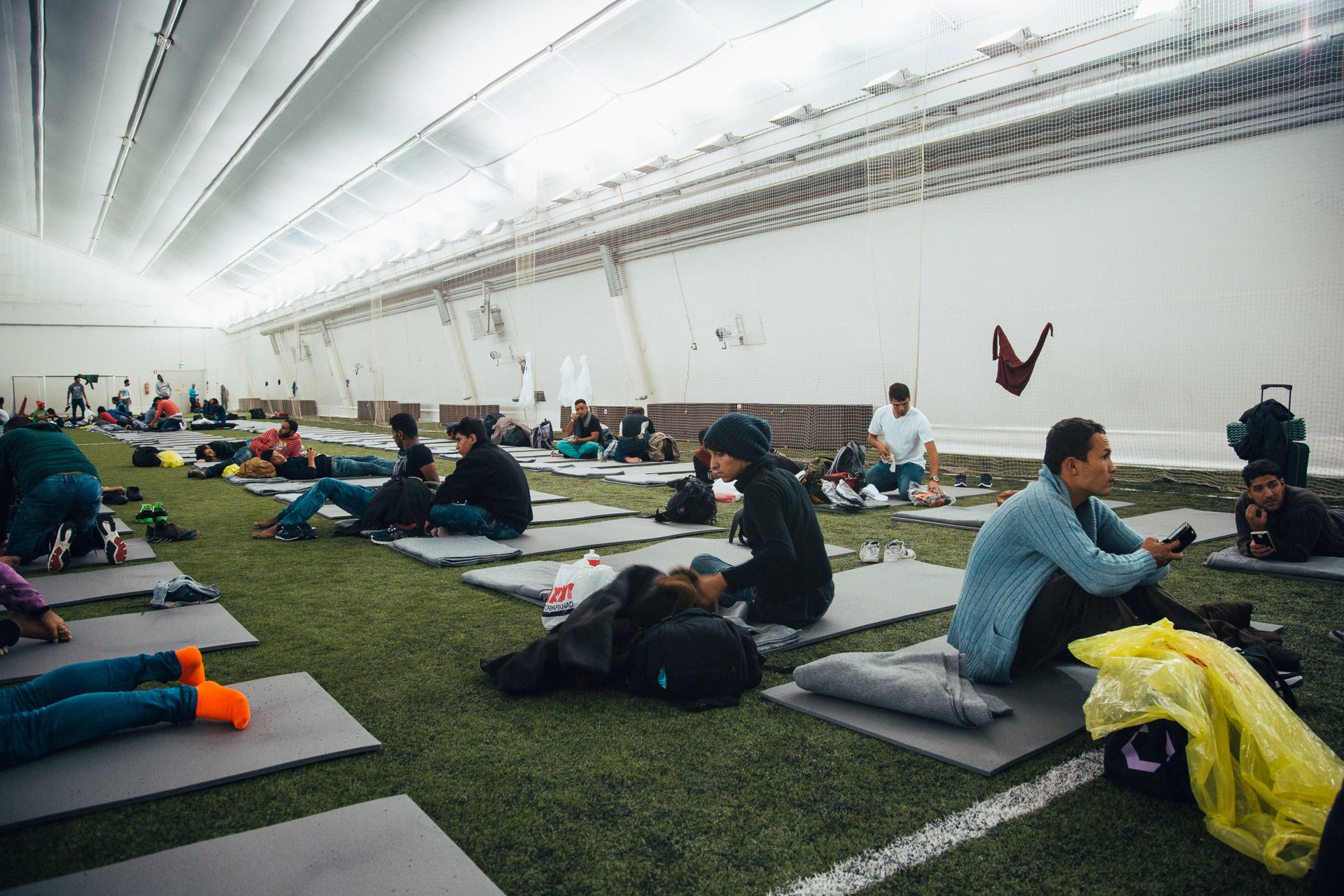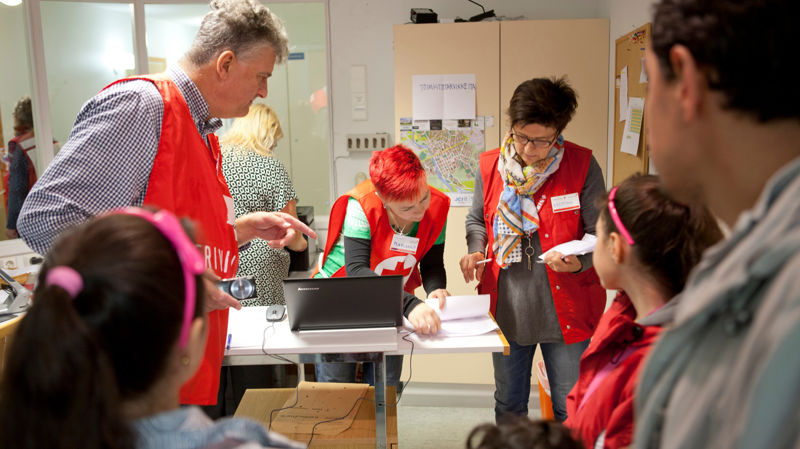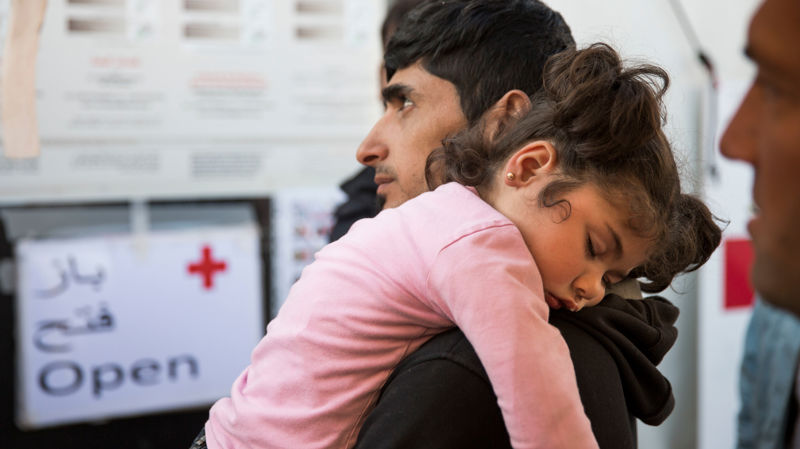An exceptional reception operation

A refugee work pioneer assesses the exceptional autumn of 2015.
In autumn 2015, a record number of asylum seekers arrived in Finland. The Finnish Red Cross played a significant role in asylum seeker reception. We established emergency accommodation for asylum seekers at a few hours’ notice, and set up as many as three reception units in one day. How do we evaluate the exceptional operation now?
The number of asylum seekers (32,476), tenfold compared to a normal year, was evident throughout Finland. The new residents added life to quiet rural villages, allowed small schools in remote villages to remain open despite decisions to close them down, and brought much-desired customers into local shops and kiosks. In the capital city, the asylum seekers blended in perfectly with the crowd.
At the height of the operation in early 2016, there were 109 Red Cross reception centres with a total capacity of almost 20,000 beds. Even more capacity could have been established, if the high immigration flows had continued.
The level of preparedness for a large-scale influx of asylum seekers had already been increased in the summer of 2015.
In the autumn of 2015, the Red Cross acted upon the request and in support of the authorities, in accordance with its mandate. The level of preparedness for a large-scale influx of asylum seekers had already been increased within the Red Cross in the summer of 2015. Training for various scenarios had been carried out, and guidelines for establishing reception centres, temporary accommodations and registration centres had been drawn up in a project for preparing for large-scale immigration (MAVA) in early 2015.
Reception work is nothing new for the Finnish Red Cross: the organisation has maintained reception centres upon the request of authorities for 30 years. The agreement on cooperation with the authorities has been in force since 1988. However, even a pioneer of refugee work had things to learn in the new situation.
Instructions to the bus driver: go south!
The last week of September 2015 was unprecedented: as many as 600 asylum seekers a day arrived via Tornio for several days, and close to 4,000 of them were registered in one week.
Thanks to the registration centre, the situation was quickly under control. The authorities proudly presented the Tornio registration centre as a model for other countries. The purpose of the registration centre was to register the immigrants and move them to reception centres or emergency accommodation in a controlled manner to wait for the asylum process to proceed.
The Red Cross was the only actor in the registration centre that was not an authority, working together with the police, the Finnish Border Guard and the Finnish Immigration Service. The role of the organisation was to bring humanity to the reception, be responsible for the accommodation and food services and take care of acute health needs.
In addition to this, the Red Cross gave the asylum seekers snacks for the bus trip, which could take a long time. On the most urgent days, the bus drivers’ only instructions were to drive southward. The precise destination only became clear during the night. Along the way, asylum seekers were dropped off at different reception centres, depending on which ones had room left.
Volunteers only had four hours to establish emergency accommodation
Meanwhile, volunteers might have had four hours to establish emergency accommodation, which the authorities might later decide to convert into a reception centre. Volunteers acquired mattresses and bedclothes and spread them out, made arrangements for donated items and prepared meals for the arriving asylum seekers.
The Red Cross was determined to make sure that everybody would have a proper place to sleep and that the basic needs (food, shelter, hygiene, health, information) were met. The Red Cross established from two to four new reception units each day over a period of 25 days in total.
The next bottlenecks: asylum process, municipal placements, employment
After the reception system and immigrant registration had adapted to the record-breaking number of immigrants, the asylum process began to become clogged up by the large number of applications. This bottleneck eased when the Finnish Immigration Service had recruited and trained enough new employees.
The Red Cross recruited 1,500 new staff members in a matter of months
The Red Cross recruited a total of 1,500 new staff members and gave them introductory training. The rapid increase in personnel was challenging, and it involved risks. Resources for HR management, financial and information management were increased. The limits of the organisation’s support services had never before been tested like this.
The Finnish Immigration Service gradually reached its target schedule in processing asylum applications, and the processing of applications of the asylum seekers who arrived in 2015 was completed in October 2017. The backlog moved to administrative courts, which have had their caseload increased significantly by the appeals by asylum seekers who received a negative decision.
It is a concern that not enough attention has been paid to the employment or educational opportunities of the people with a residence permit when granting them a place in a certain municipality. Due to the appeal process and the small number of municipal placements, the reduction in the number of people in reception units has been slower than calculated, and the Finnish Immigration Service has had to cancel reductions in reception capacities and delay the planned closure of reception centres. This caused some of the employee co-operation negotiations to have been conducted unnecessarily.
Moving asylum seekers from one area to another – and then another
The Finnish Red Cross has closed down dozens of the reception centres it had maintained since the autumn of 2015. The adjustment rounds will continue, unless new events occur in immigration. Flexibility has been required from both reception centre workers, as well as the asylum seekers: the workers have been afraid for their jobs, and the asylum seekers who have just started to integrate in the community have been distressed by the possibility of moving elsewhere.
The Red Cross units have been flexible and ready to receive more residents than specified in the agreement, meaning that they have operated without additional resources, when necessary. For the asylum seekers, only the luckiest ones originally ended up in a unit where they could stay for the whole waiting time. Due to circumstances beyond the Red Cross’s control, asylum seekers have had to move three times in two years on average, or even up to nine times.
Hundreds of property owners were willing to offer their facilities to serve as reception centres. Some locations were excellent, with responsible owners willing to make the necessary changes and negotiate a reasonable rent. Some took advantage of the situation and managed to get their real estate allocated for use as a reception centre, despite its poor condition.
The Red Cross took advantage of its expertise in international aid
The Red Cross operation phase, during which exceptional measures and the resources of the whole organisation were used, lasted for a year. The organisation received a great deal of recognition for its activities from the authorities, according to whom the large-scale reception of asylum seekers could not have been accomplished without the Red Cross. In late 2016, the reception activities became a part of the Red Cross’s normal programming.
According to the internal assessment commissioned by the Finnish Red Cross in the spring of 2017, the Red Cross was successful in the reception operation because the staff and the volunteers gave an outstanding contribution and rose to the challenges of the situation, and because the organisation had amazing abilities to learn very quickly.
The Red Cross is a genuinely local actor with a good and confidential relationship with the local authorities and other actors. Moreover, the Red Cross is also an international actor, which meant that the organisation received information about the number of immigrants and their routes, and was linked to the countries involved in the European-wide migration response through its international network.
One hundred aid workers contributed to the operation in Finland.
The Red Cross took advantage of the expertise and resources of international aid extensively. One hundred aid workers, many of whom were experienced in working in refugee camps, contributed to the operation in Finland. They received good feedback. They were easy to work with as they had been used to working all over the world in challenging and rapidly changing situations.
As for the Kalkku logistics centre, it assisted with centralised procurement and innovated product packages delivered to the newly established units. The mobile health team, which is often used internationally, was adapted to Finnish conditions to help with easing the backlog in the asylum seekers’ health checks, amongst other tasks.
Criteria for a successful operation
The Red Cross still has much to learn from the operation, both externally and internally.
Externally, cooperation with the authorities and the civil society sector, as well as with businesses, can still be developed. For example, operation room expertise and information exchange with the authorities must be developed, so that the overall picture is up to date and the development of the situation can be monitored proactively. The coronavirus situation in 2020 and 2021 serves as an example of this.
The national reception and integration support network of organisations, created in 2015 to coordinate the cooperation between organisations and their desire to help, meets regularly and is coordinated by the Red Cross. The network maintains the situational picture of third sector operations and improves dialogue with the authorities.
Responding to the cooperation offers of companies, as well as the ability to receive and handle donations, are being continually developed.
Internally, leadership is made clearer and cooperation between Red Cross districts is developed.
Additionally, the inclusion of more volunteers is made easier. In the autumn of 2015, there was no system in place to guide the hundreds of eager volunteers each day to do work that was both interesting and necessary for the operation. This lack of procedure initiated the project to improve digital services, which lead to the development of the volunteer system ‘Oma Punainen Risti’, which we have now been using since 2019.
The reception operation crystallised the criteria for a successful operation. The criteria include good management; clear roles and division of labour; common rules and commitment to them; an operational overview based on up-to-date information; and sufficient human resources. Other important factors include the systematic planning of operations, taking the beneficiaries into account, flexibility and the ability to make quick decisions.
Immigration volume challenged the whole of society
The preparedness of the Red Cross as a whole grew stronger as a result of the reception operation. The importance of preparedness affects the whole organisation and is more visible in it than before. It is considered everyone’s business.
Pre-agreements are necessary for ensuring a proper level of preparedness. The agreement between the Red Cross and the Finnish Immigration Service defines the role of the organisation and its tasks in the reception of asylum seekers, in particular in a large scale situation. If the roles are not clear and have not been agreed upon in advance, time is wasted at a time when full action should already be underway.
Many of the Red Cross’s operating methods were adapted during the operation, and the same approach is still valid today. The large numbers of asylum seekers was a new phenomenon for all actors and the whole of society. New solutions are required, as well as close cooperation with different actors and a constant desire to tackle the challenges.
It would be wonderful to find a Finnish friend for each new immigrant!
The Red Cross considers it important to invest in two-way integration. Development and changes occur in the lives of both the original population as well as the immigrants. The integration of the immigrants into Finland is supported based on individual needs. At the same time, the ability of communities to receive new immigrants and act against racism and hate speech must also be reinforced.
The focus of volunteer activities has moved to supporting integration and providing friends for immigrants. Volunteers introduce asylum seekers and people who have been granted a residence permit to Finnish culture and customs and make them feel like part of their immediate community and the society around them. The dream is for every immigrant to find a Finnish friend!
Article first published in October 2017. Updated in February 2021.

